The Allure of Million Dollar Rings: An In-Depth Exploration
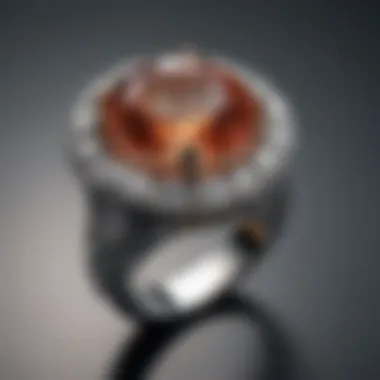
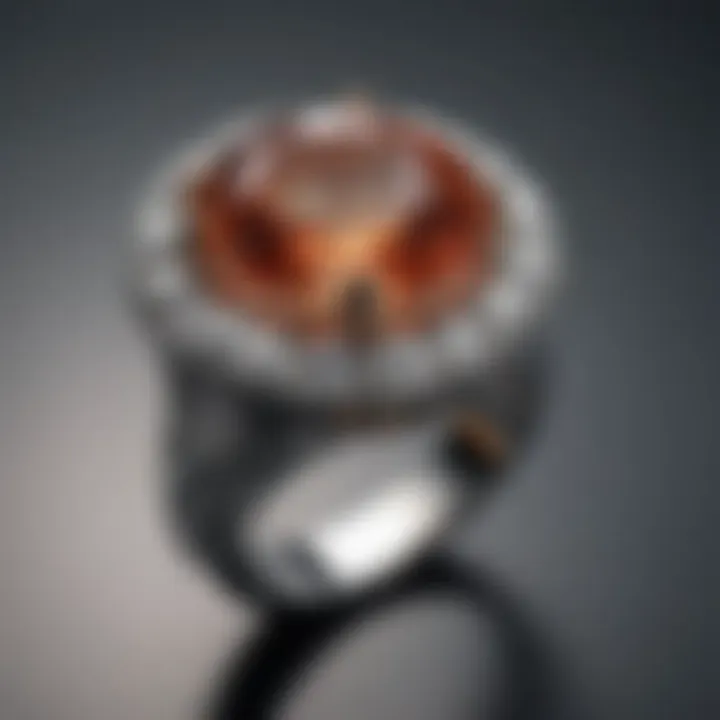
Intro
The world of million-dollar rings serves as both a symbol of status and an object of fascination. Beyond mere jewelry, these pieces often carry stories, showcasing a blend of artistic craftsmanship and cultural significance. Their appeal extends beyond the aesthetic, touching on historical narratives, societal values, and ethical considerations surrounding the sourcing of precious materials. This exploration underscores the complexities that elevate certain rings to extraordinary valuations, drawing interest from collectors and enthusiasts alike.
Gemstone Overview
Definition and Characteristics
Gemstones are naturally occurring minerals that are prized for their beauty, durability, and rarity. A gemstone becomes more valuable if it possesses qualities such as brilliance, clarity, and color. Not all minerals qualify as gemstones; only those that have been cut and polished to enhance their intrinsic qualities can be classified as such.
Classification of Gemstones
Gemstones can be classified into two main categories: precious and semi-precious stones.
- Precious Gemstones
- Semi-Precious Gemstones
- Diamond: Renowned for its exceptional hardness and brilliance.
- Ruby: Known for its rich red color.
- Sapphire: Valued for its deep blue hue and durability.
- Emerald: Cherished for its vibrant green color.
- Amethyst: A popular purple quartz variant.
- Topaz: Available in various colors, prized especially in golden tones.
- Garnet: Found in a range of colors, commonly red.
Properties of Gemstones
Physical Properties
The physical properties of gemstones include features such as hardness, luster, and transparency. Hardness is measured by the Mohs scale, providing insight into how resistant a stone is to scratching. Luster describes the way a surface reflects light, which can range from glossy to dull.
Chemical Properties
Chemically, gemstones are made up of distinct mineral compositions. Each gemstone has a unique chemical formula that contributes to its characteristics. For instance, the chemical formula for diamond is crystallized carbon, while emerald consists of beryllium aluminum silicate. Understanding these properties is essential for experts in identifying and valuing gemstones.
"The allure of million-dollar rings is not solely in their visual appeal, but also in the stories each stone can tell."
Prolusion to Million Dollar Rings
Million dollar rings represent a unique intersection of art, luxury, and symbolism. Their allure is not just about price tags; they encapsulate rich histories, cultural narratives, and personal stories. Exploring this domain opens a window into human desires for beauty and status, illuminating why these rings have a special place in our society.
Definition and Characteristics
A million dollar ring typically embodies exceptional craftsmanship and materials. It often features rare gemstones such as diamonds, emeralds, or sapphires, each selected for their clarity, color, and carat weight. The setting can vary from ornate to minimalist designs, but quality is paramount.
Characteristics of these rings include intricate detailing and unique elements that set them apart from standard jewelry. For instance, many have a signature cut or distinctive engraving. The weight of the gold or platinum used also matters. Heavy metals may signify durability, making the ring a lasting piece of art rather than mere decoration.
Cultural Significance
Million dollar rings hold substantial cultural significance beyond their monetary value. Traditionally, they symbolize milestones such as engagements or weddings, encapsulating commitment and love. Celebrities often choose extravagant rings, further amplifying their status in popular culture.
The fascination with what such rings represent can be seen in various societies. They serve as conversation starters and status symbols, influencing people’s understanding of wealth and beauty. As societal norms evolve, the meaning behind these rings can shift, indicating changes in values and aspirations.
"A ring is not just a piece of jewelry; it is a reflection of one's personal history, cultural context, and emotional depth."
Through their definitions and cultural connections, million dollar rings reflect more than affluence; they are narratives rooted in human experiences and societal shifts.
Historical Context
Understanding the historical context of million-dollar rings provides invaluable insight into their significance and evolution. Historical perspectives reveal how these exquisite pieces have transcended mere adornment to embody power, status, and emotional resonance in various cultures. The evolution of craftsmanship, use of materials, and deliberate design choices over centuries reflects a constant interplay between societal values and the artistry of jewelry makers. By delving into the past, one can appreciate how these rings not only serve as luxuries but also as artifacts that narrate the tales of those who wore them.
Rings in Antiquity
Rings have existed since ancient times, serving practical and symbolic purposes. In antiquity, rings were primarily used to signify allegiance, authority, and ownership. Their design often included intricate engravings or embedded gemstones, which were thought to hold mystical properties. Different civilizations, such as the Egyptians and Romans, utilized rings in unique ways, incorporating them into both everyday life and significant rituals.
The Egyptian signet rings, for instance, were a status symbol, frequently used in legal transactions. They featured hieroglyphs or depictions of deities, representing a divine connection. In Roman culture, rings were also a reflection of social class. Wealthy individuals wore elaborate designs, often adorned with precious stones like sapphires or emeralds, while simpler styles were common among the less affluent.
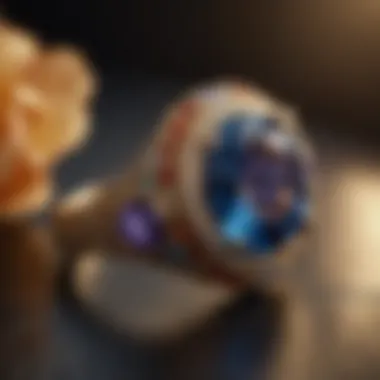
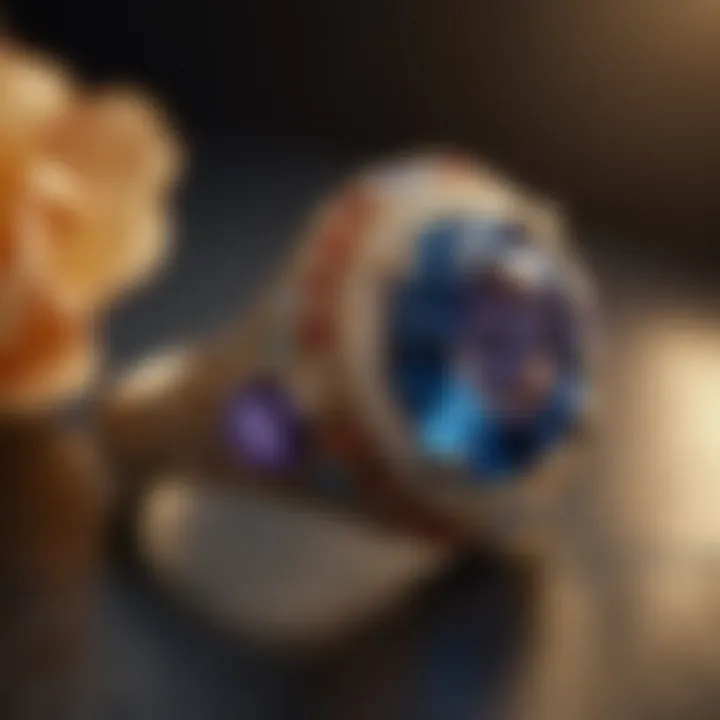
Today, some of these ancient ring designs influence modern jewelry trends. The enduring appeal lies in their rich heritage and the craftsmanship that has evolved over millennia, connecting the past with the present.
Notable Historical Examples
Several rings throughout history stand out due to their unique characteristics and the stories behind them. One example is the "Pope’s Ring" or the Fisherman’s Ring, which symbolizes the authority of the Pope. Traditionally, it has served not just as a personal item, but as a tool for authentication and authority in the Catholic Church.
Another significant example is the engagement ring worn by Queen Victoria, which featured a turquoise and diamonds. This choice by a royal figure influenced a shift in societal norms regarding engagement rings, promoting the diamond as the key gemstone for such occasions. This history has led to the diamond’s status today as the preferred choice for engagement and significant rings.
These examples highlight how certain rings have left an indelible mark on culture and continue to shape consumer preferences and societal norms surrounding luxury jewelry. Understanding these historical milestones will aid in discerning the present trends and the future trajectory of million-dollar rings.
Design Elements
Design elements for million-dollar rings encompass both aesthetic qualities and technical craftsmanship. These elements can create a true masterpiece that captivates not just the eye, but also the heart of collectors and enthusiasts alike. In the domain of luxury jewelry, every small detail has significant weight. A ring's design can not only enhance its visual appeal but also communicate personal stories and values. This section will delve into the craftsmanship techniques and how style trends have evolved over time.
Craftsmanship Techniques
Craftsmanship in high-value rings is a blend of artistry and skill. Jewelers often employ a range of techniques that have been passed down through generations. For instance, hand-setting of stones is a meticulous process, requiring not only skill but also patience. Each gemstone is placed with precision, ensuring it reflects light in a way that maximizes its beauty. This technique contrasts with machine-setting, which, while efficient, lacks the personal touch that is often desired in high-end jewelry.
Furthermore, techniques like filigree—an intricate method of designing with delicate threads of metal—add depth and character to a ring. This fine detail enhances both the structure and the appearance, making the ring unique. In addition, many luxury rings feature complex engraving that tells a story or holds personal significance. Such craftsmanship elevates a ring from mere adornment to a significant emotional artifact.
Style Trends through the Decades
Over decades, the styles of million-dollar rings have shifted significantly, reflecting societal changes and evolving taste. In the early 20th century, Art Deco was synonymous with geometric shapes and vibrant gemstones. Rings from this era often featured bold designs, embodying the spirit of modernity.
As we moved through the decades, the influence of different art movements can be observed. The mid-century saw a rise in minimalist styles, where less became more. Designs were clean and focused, prioritizing the quality of materials rather than excessive embellishment. Today, many designers are returning to vintage aesthetics while integrating modern elements, creating a hybrid that appeals to contemporary consumers.
"The allure of a luxury ring is often found in the story it tells, transcending the mere value of its material components."
In summary, the evolution of design elements in million-dollar rings not only highlights the progression of artistic expression but also serves as a reflection of cultural narratives. Collectors and enthusiasts should not only consider the visual appeal but also appreciate the depth of craftsmanship and its historical context.
Materials Used in Million Dollar Rings
The significance of materials in million-dollar rings is foundational to their value and allure. Each component contributes not only to the ring's aesthetic but also to its investment potential. Buyers often seek rings crafted with rare and high-quality materials, which can significantly influence the cost.
Gemstones
Gemstones are the primary focal point in million-dollar rings. The choice of stone often defines the ring’s overall character and significance. Not just any gemstone can qualify; rarity, size, and quality determine desirability. For instance, diamonds remain the classic choice, often epitomized by their brilliance and hardness. However, other gemstones like emeralds, sapphires, and rubies also attract collectors and investors due to their unique colors and historical contexts.
- Rarity of Gemstones: The market values gemstones based on their scarcity. For example, fine-quality pink diamonds are held in higher esteem because they are much less common than their white counterparts.
- Gem Quality Indicators: Cut, clarity, color, and carat weight are the four C's essential in evaluating gemstone quality. Each C impacts the beauty and ultimately the price:
- Cut: A well-executed cut enhances a gemstone's sparkle.
- Clarity: Fewer inclusions lead to higher value.
- Color: Saturated and vivid colors result in greater desirability.
- Carat Weight: Larger gemstones hold more value per carat.
Metals and Alloy Compositions
The metal used in a million-dollar ring is equally important as the gemstone. The choice reflects not only the ring's durability but also its style and personal significance to the owner.
Popular metals include:
- Gold: Available in yellow, white, and rose varieties, gold rings often signify luxury and tradition. The karat measurement indicates purity; 24-karat is the purest form.
- Platinum: Known for its strength and rarity, platinum is resistant to tarnishing, making it ideal for intricate designs and long-lasting settings.
- Palladium: This is a modern alternative to platinum. It is lighter and less expensive, appealing to a broader audience.
Alloys also play a crucial role. For example, gold is often alloyed with metals like copper or silver to enhance its strength and alter its color. The choice of alloy not only affects durability but also influences how a ring will react to everyday wear.
Understanding the materials used in million-dollar rings equips buyers and collectors with the knowledge needed to make informed decisions about value and investment. The combination of exquisite gemstones with opulent metals creates pieces that are not merely decorative, but also serve as a testament to craftsmanship and value.
"The true value of a ring is not just in its materials but also in the stories and emotions it carries throughout its life."
As the landscape of luxury jewelry continues to evolve, the materials remain central to both appreciation and investment in million-dollar rings.
Celebrity Influence and Iconic Rings
The impact of celebrities on luxury rings is undeniable. Their choices often set trends and shape perceptions about what constitutes a valuable piece of jewelry. High-profile engagements, in particular, catapult specific rings into the spotlight, making them desirable commodities for both fans and collectors. The allure of million-dollar rings is intensively magnified when linked to personal stories of celebrities, adding layers of significance beyond mere monetary value.
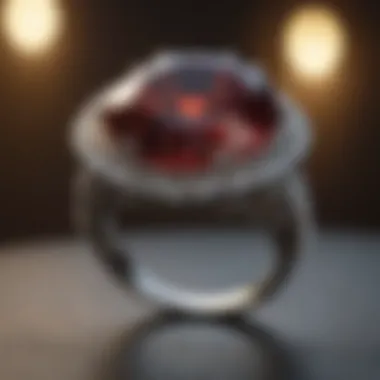
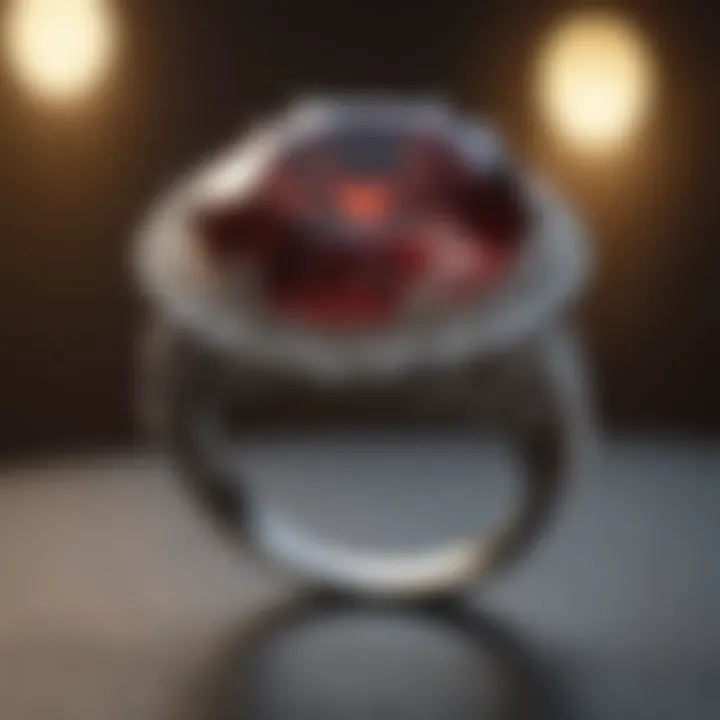
Famous Celebrity Engagement Rings
When considering famous engagement rings, a few examples stand out due to their combination of unique design and extravagant valuation. One of the most notable is the engagement ring of Jennifer Lopez, featuring a stunning 6.1-carat pink diamond, designed by Harry Winston. This specific choice resonated throughout the jewelry industry.
Another famous example includes the 20-carat diamond ring given to Elizabeth Taylor by Richard Burton. This ring not only represented their tumultuous relationship but also exemplified a specific era's appreciation for opulent jewelry. Additionally, Meghan Markle's engagement ring, which incorporates diamonds from Princess Diana’s collection, has brought a contemporary perspective to traditional designs.
These rings serve as a reflection of personal history and cultural significance. The following traits are often noted:
- Size and Carat Weight: Rings with exceptionally large stones attract immediate attention.
- Design Elements: Unique styles, such as vintage cuts or modern settings, can enhance desirability.
- Provenance: Rings with a notable history or connection to celebrity figures often fetch higher values.
Cultural Impact of Celebrity Choices
The impact of celebrity choices is profound, influencing public opinion and jewelry trends. Celebrities have transformed the engagement ring from a traditional symbol of love into a statement piece that conveys individuality and status. The value attached to these rings often carries over to the everyday consumer, creating a demand for similarly styled pieces, regardless of actual budget.
Furthermore, engagement rings often become points of discussion, allowing fans and observers to engage with the personal lives of public figures. This mix of spectacle and intimacy creates a narrative surrounding the jewelry that goes beyond just aesthetics.
A few points illustrate this cultural impact:
- Trend Setting: High-profile engagements often lead to spikes in interest for similar styles, like colored stones or intricate settings.
- Symbolism: These rings often symbolize aspirations toward a certain lifestyle, making them a common discussion topic.
- Market Shift: There is a real-time shift in the jewelry market as consumers actively seek rings resembling those of their favorite celebrities.
"The engagement ring has evolved into not just a piece of jewelry, but a cultural icon that defines personal values and societal aspirations."
Market Dynamics of Luxury Rings
The market dynamics of luxury rings plays a crucial role in understanding their allure and the factors that contribute to their high valuation. The interplay of demand and supply in the luxury jewelry sector shapes the landscape of million-dollar rings. Notably, consumer expectations, market trends, and economic conditions are pivotal in influencing their pricing and desirability.
High-value rings often signify status, love, and cultural importance, making them integral to various life events. The increasing number of affluent individuals worldwide further stimulates demand. This segment of consumers often seeks unique and luxurious pieces that not only exemplify personal style but also serve as investments. Additionally, brand reputation and craftsmanship significantly impact how rings are perceived in the market.
Effective marketing strategies employed by luxury jewelry brands contribute to the allure and perceived value of their offerings. These strategies highlight exclusivity and rarity, which resonate deeply with potential buyers.
Valuation Criteria
The valuation of million-dollar rings involves meticulous consideration of several criteria.
- Gemstone Quality: The quality of the gemstones is paramount. Cut, clarity, color, and carat weight determine their value. Higher quality often equates to higher prices.
- Craftsmanship: The skill and techniques used in crafting the ring also play a significant role. Handmade pieces by renowned artisans can command higher prices due to their unique nature.
- Brand Recognition: Established brands often fetch greater prices due to their reputation in the luxury goods market.
- Market Demand: Trends play a significant role; when a specific style becomes popular, demand surges, affecting valuation.
These aspects are often assessed by gemologists who provide detailed reports, ensuring buyers are well-informed.
Investment Potential
Investing in luxury rings can be complex but rewarding.
- Value Appreciation: Over time, high-quality luxury rings tend to appreciate, making them attractive investment options. Rare gemstones often yield better returns due to their scarcity.
- Tangible Asset: Unlike stocks or bonds, luxury rings are tangible assets. This physicality offers a sense of security for investors.
- Cultural Legacy: Rings carrying historical or artistic significance can increase in value, appealing to collectors and investors.
However, it is essential for potential investors to conduct thorough research and consider fluctuations in market trends before committing large amounts to such investments.
"Understanding the market dynamics is indispensable for appreciating the full value of million-dollar rings, both as personal treasures and investment opportunities."
As we delve into the ethical considerations and sourcing practices in the jewelry industry in subsequent sections, the importance of transparency in the luxury market becomes even more evident.
Ethical Considerations in the Jewelry Industry
The jewelry industry, particularly in the context of million-dollar rings, is increasingly scrutinized for its ethical practices. As consumers become more aware, the demand for ethically sourced materials has grown. This transformation highlights the significance of evaluating and understanding the implications surrounding gemstone sourcing and the broader jewelry production process. In this section, we will delve into the sourcing and sustainability issues, as well as the need for transparency in gem sourcing.
Sourcing and Sustainability Issues
Sourcing gemstones can have profound environmental and social implications. The extraction of precious stones often occurs in regions with weak governance, poor labor laws, and minimal environmental protections. This can lead to significant issues, such as deforestation, loss of biodiversity, and adverse effects on local communities.
Moreover, many gemstones are extracted in conflict zones. The term "blood diamonds" is well-known, referring to diamonds that fund violence and human rights abuses. The ethical sourcing of gemstones is crucial, as it helps consumers avoid inadvertently supporting these illicit activities.
Businesses in the luxury jewelry sector are making strides toward sustainable practices by prioritizing responsible mining techniques and supporting local communities economically. This proactive approach not only aids in the preservation of the environment but also enhances the brand reputation, appealing to conscious consumers.
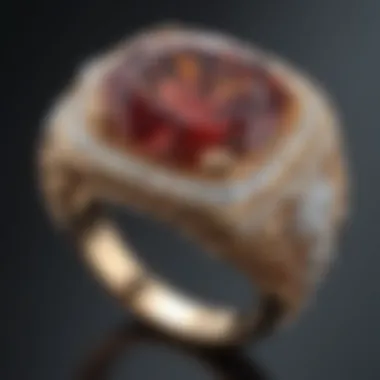
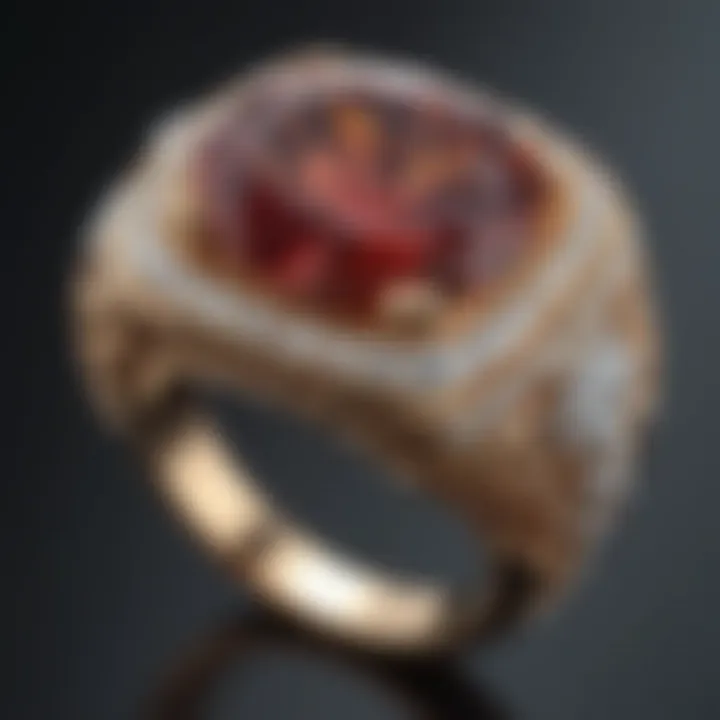
Transparency in Gemstone Sourcing
Transparency is paramount in the jewelry industry, particularly when discussing million-dollar rings. Consumers increasingly demand that brands disclose the origins of the gemstones used in their products. This includes providing information on how and where the stones were mined and whether ethical labor practices were followed.
A robust transparency framework can establish credibility for jewelers. Certifications, like the Kimberley Process for diamonds, strive to ensure that gemstones are not tainted by conflict. However, its effectiveness is sometimes questioned, highlighting the need for a more comprehensive accountability system across the industry.
When jewelers adopt transparent practices, it not only strengthens consumer trust but may also promote a more sustainable industry standard. As environmental and social justice issues continue to shape consumer expectations, the ability to trace a gemstone's journey is essential.
"Ethical sourcing is not just a trend; it's a necessity to ensure a sustainable future for the jewelry industry."
In summary, the importance of ethical considerations cannot be overstated. By understanding sourcing and sustainability issues alongside transparency in gemstone sourcing, consumers and producers alike can contribute to a more responsible and ethical jewelry industry.
The Role of Gemology
Gemology plays a crucial part in understanding the allure of million-dollar rings. This discipline focuses on the study, identification, and evaluation of gemstones. With high-value rings, it is essential to grasp the properties of the gemstones involved. Understanding gemology allows buyers, sellers, and collectors to make informed decisions in the luxury jewelry market.
Gemology offers insight into various factors that influence the value of a gemstone, including color, clarity, cut, and carat weight. These factors not only drive demand but also help establish authenticity and provenance. A well-informed buyer appreciates subtleties that elevate a ring's status, thus reinforcing the importance of gemology in assessing luxury jewelry.
Additionally, the role of gemology extends to ethical considerations in sourcing gemstones. Ensuring that gemstones are sourced responsibly is paramount. Gemologists can provide certifications that signify the ethical origin of stones, thus appealing to consumers who are increasingly concerned about sustainability and ethical practices in the jewelry industry.
Understanding Gemstone Characteristics
To comprehend the value and beauty of million-dollar rings, one must be familiar with gemstone characteristics. Each gemstone has unique attributes that affect its quality and market value. Critical characteristics include:
- Color: The hue or shade of a gemstone can drastically affect its desirability. For instance, vivid colors are more sought after.
- Clarity: This refers to the absence of inclusions or blemishes. Higher clarity usually results in a more valuable stone.
- Cut: The way a gemstone has been shaped and polished can influence its brilliance. Excellent cut maximizes light reflection, enhancing the gem's appearance.
- Carat Weight: This indicates the weight of the gemstone. Generally, larger stones command higher prices, although this is not the only factor.
Understanding these features helps collectors identify valuable pieces and avoid overpaying for lower-quality stones.
Evaluating Authenticity
Evaluating authenticity is vital in the world of luxury rings. As market demand increases, so does the prevalence of counterfeit gemstones. Buyers must carry out due diligence when acquiring high-value pieces. Here are key methods to ensure authenticity:
- Professional Appraisal: Consulting a certified gemologist provides authority on the quality and authenticity of a gemstone.
- Certification: Reputable stones should come with a grading report from recognized institutions. This document verifies the gem’s characteristics and provenance.
- Testing: Various tests, such as refractive index and thermal conductivity, can help identify whether a gemstone is genuine.
- Visual Inspection: Learning to recognize signs of natural versus synthetic stones can aid in identifying authenticity.
By understanding gemology, potential buyers can confidently navigate the luxury jewelry landscape, ensuring they make intelligent purchases.
Future Trends in High-Value Jewelry
Understanding future trends in high-value jewelry is essential as these trends shape consumer behavior and industry standards. The market for luxury items, such as million-dollar rings, is influenced by various factors including societal shifts, technological advancements, and ethical considerations. Staying abreast of these trends helps gemstone enthusiasts, collectors, and jewelry designers align their preferences and offerings with what is emerging in the marketplace.
Evolving Consumer Preferences
Consumer preferences are a significant aspect of the high-value jewelry market. More buyers are seeking unique pieces that reflect individual style rather than mass-produced designs. This shift towards personalization means that custom-made rings are growing in popularity. Consumers now prioritize authenticity and story over mere brand recognition. They are increasingly informed and conscientious, focusing on quality, craftsmanship, and the origin of materials. This evolution in preferences pushes retailers toward offering more bespoke options to cater to discerning tastes.
Moreover, the rise of social media has reshaped how consumers discover and engage with brands. Platforms like Instagram provide a space where trends can quickly gain traction. This visual-centric approach allows consumers to connect emotionally with products they see online. Brands that leverage this trend can build a stronger rapport with buyers by showcasing their craftsmanship and design story. In addition, sustainability and ethical considerations are also influencing consumer choices. Shoppers are becoming aware of the environmental and social impacts of their purchases, leading them to choose brands that align with their values.
Technological Innovations
Technological advancements play a pivotal role in the luxury jewelry sector. Innovations in design software and 3D printing technology allow for intricate detailing that was previously difficult or time-consuming to achieve. Jewelry designers can now experiment with complex forms and customized designs efficiently. This technology not only streamlines production but also enables more personalized experiences for consumers.
Moreover, blockchain technology is gaining traction in the gemstone industry. By providing an immutable record of a gemstone's provenance, this technology enhances transparency and trust among consumers. Buyers can trace the origins of their pieces, ensuring they are investing in ethically sourced materials. Blockchain aids in verifying authenticity, adding value for consumers who prioritize integrity in their purchases.
The intersection of evolving preferences and technological advancements heralds a new era for the luxury jewelry market, promising innovative designs and ethically sourced materials.
The End
The concluding section of this article emphasizes the significance of million-dollar rings in contemporary society, presenting a multifaceted appreciation for these exquisite items of jewelry. Million-dollar rings encapsulate not only personal stories of love and commitment but also represent unparalleled craftsmanship and artistry. They hold cultural relevance, reflecting social status and influence while often embodying individual anecdotes that resonate deeply with their owners.
Summarizing the Worth of Million Dollar Rings
Understanding the worth of million-dollar rings requires an examination of various interconnected factors. Firstly, each ring often serves as a symbol of significant life events, such as engagements, weddings, or anniversaries. This added emotional value enhances the perceived worth beyond mere material elements.
Additionally, the valuation of these exquisite pieces can be attributed to numerous criteria:
- Gemstone Quality: The rarity and quality of the gemstones play a crucial role. High-quality diamonds, sapphires, or rubies, especially those with exceptional cut, clarity, color, and carat weight, contribute immensely to a ring's value.
- Designer Craftsmanship: Renowned designers and jewelers, such as Harry Winston or Cartier, add prestige to pieces. Collectors often seek rings from esteemed names, knowing the recognition of the designer elevates the overall worth.
- Historical Significance: Rings with historical backgrounds or those once owned by famous individuals can fetch extraordinary prices at auctions due to their unique provenance.
In a market where the aesthetics and the emotional implications intersect, million-dollar rings represent the culmination of passion, skill, and investment. This article aims to provide insight into the layers of meaning that add to their allure, appealing to gem lovers, jewelry collectors, and industry aficionados alike.



